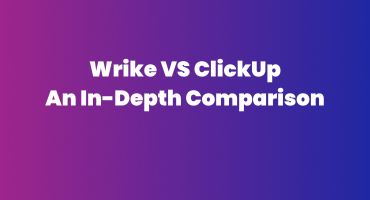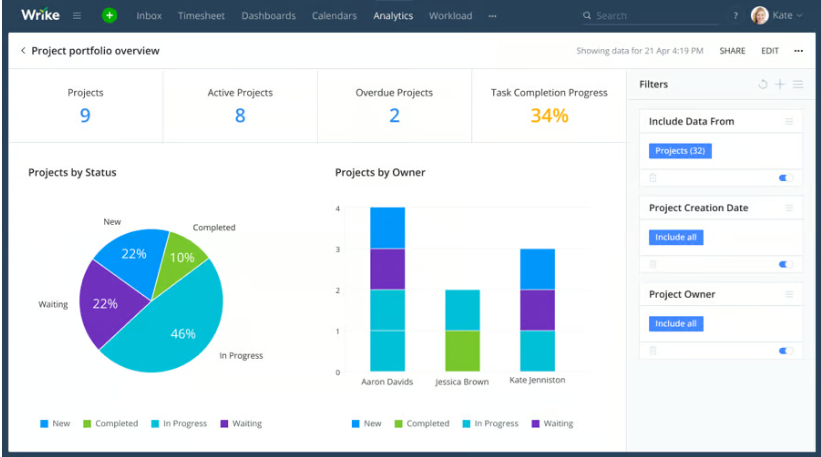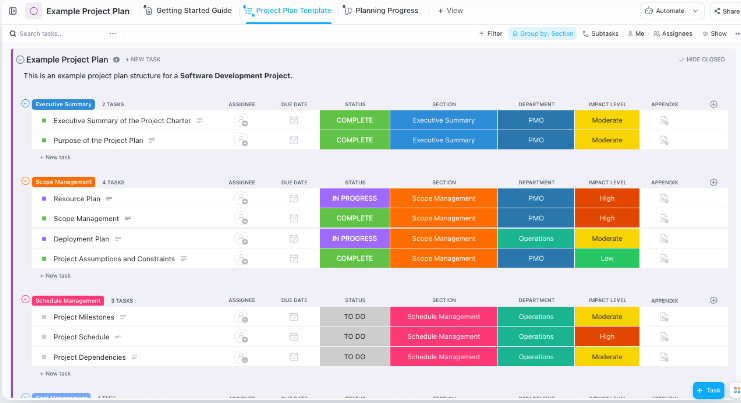
Continuous innovations in technology have opened modern ways to manage businesses while setting more challenging targets. The project management software sector is also experiencing exponential growth, with innovative features emerging every day to tackle these managerial challenges peacefully. Without an effective project management tool, managers find themselves struggling, which leads to poor project scheduling, work prioritisation, and deadline overruns.
Out of the many remarkable project management software options in the market, this article will provide you with an in-depth comparative analysis of industry’s strong competitors – Wrike and ClickUp. This might help you in taking the right decision while choosing one of them.
So let’s get started!
Comparative Analysis: Features and Functionality
Wrike and ClickUp are indeed the striking project management tools offering a strong set of features uniquely designed to help teams stay organised and enhance productivity.
Wrike: was founded in 2006 by Andrew Filev. Wrike, Inc. is an American project management application service provider based in San Jose, California. Over the years, Wrike has grown to become a project management app that doubles as a collaborative work management tool, catering to businesses of all sizes.
On the other hand, ClickUp was originally conceived by founder Zeb Evans as an internal tool to manage his team’s work in one place. The vision behind its creation was to make the world more productive. Today, ClickUp has grown into an all-in-one productivity platform where teams can plan, organise, and collaborate on work in a centralised workspace.
Key Features of Wrike
- Wrike is a collaborative work management that qualifies as a suitable companion for any organisation looking to scale. Key features includes:
- Task Management: Unlimited number of items — folders, projects, tasks, and subtasks, can be created by interconnecting using task dependencies and assigned to responsible team members.
- Work Views: Wrike offers improved project views such as Calendar view, Board view, Table view and Gantt Charts to visualise project work with increased efficiency.
- Dynamic Request Forms: Automate your work intake, route all requests to one place from internal and external customers, and ensure requesters provide the information you need.
- Workload charts: With effort and resources estimations, Wrike offers workload charts to visualise and manage capacity allocation of the team.
- Wrike Lock: Wrike offers an additional layer of data protection by applying Wrike lock feature on workspace data and attachments.
- Workload and Budget Dashboards: Real-time reporting feature enables export time tracking data integrated with billing and invoicing modules, all offered in Wrike.
Key Features of ClickUp
- ClickUp the all-in-one project management tool having powerful features includes:
- Hierarchy: ClickUp unique Hierarchy helps to create the perfect structure that scales with business needs.
- ClickApps: Up to 35+ ClickApps helps to customise task management according to specific project type or process i.e. sprints in agile workflow, task dependencies, work-in-progress limit etc.
- Nested Subtasks & Checklists: Simplify complex projects by breaking them down into levels of nested subtasks.
- In-app Chat: Real time updates can be shared by using chat feature in ClickUp
- Work Scheduling: Project views like calendar view, workload view and Gantt charts allows project managers to do project planning, monitor project health and set dynamic timelines for tasks.
- In-App Video Recording: This unique feature allows team members to convey message in screen recordings without any long threaded emails or meetings.
User Interface and Ease of Use
Wrike features a user-friendly and contemporary interface. Upon logging in, the default dashboard conveniently displays all your projects, tasks, and spaces, enabling users to immediately determine the next course of action. Wrike has also updated its interface based on extensive UX research and user feedback. The new interface addresses information overload and discoverability, keeping the interface elegant and approachable as businesses grow.
ClickUp has a modern and intuitive user interface, making it easy to navigate and use. The left-hand menu of ClickUp interface includes Home, Notifications, Pulse, Goals, Favourites, and Spaces. Each of these elements serves a specific purpose, making it easier for users to locate and manage their tasks and projects.
Team Collaboration and Communication
Effective Collaboration cannot be achieved without well-designed communication tools which simplify the process of sharing information and updating action items about any uncovered issues, uploading resources or providing the sign offs.
Both tools offer a variety of collaboration tools as follows:
Wrike:
- Smart Approval: Wrike offers users to collaborate during automated approval processes for document, decisions and sign-off requests.
- Proofing: The team can collaborate on project assets like images, documents, videos, etc., to get feedback from stakeholders directly on the assets. This process records all proofs, changes, and approvals.
- Shareable Dashboards: This feature allows users to stay informed about project progress stats on a shared dashboard with real-time data. It thus encourages collaborative efforts to meet common targets.
ClickUp:
- Collaborative Editing: This feature displays a live cursor for each user during document editing, enabling real-time updates and reducing errors and time spent.
- Whiteboard: In ClickUp, teams can use whiteboards to brainstorm, discuss ideas, and create notes. This facilitates the conversion of these ideas into tasks.
- @mentions and Assignee: Team efficiency is enhanced when members are clear on their assigned tasks. Additionally, @mentions in chat discussions, task descriptions, or comment sections foster common understanding.
- Custom workflows: Teams can enhance their collaborative workflows to include any overlooked collaborations that were lost in chats or comments, learning from the challenges of past projects.
Reporting And Analytics
Robust reporting and analytics features that provide insights and help track progress are essential tools that every business require. Let’s go through Wrike and ClickUp offerings:
Wrike offers a comprehensive suite of reporting and analytics features:
- Interactive Analytics Dashboards: Wrike has dynamic widgets, provides an intuitive interface for users to build interactive reports from pre-built templates having advance analytics tools.
- Advance Filtering and Formulas: Wrike widgets supports custom calculations on slice and diced data to provide insights on required metrics.
- Forecasting: In Wrike forecasting feature provides trends, identify patters and predict future outcomes based on the historical projects data.
- Real-time Shareable Dashboards: Wrike offers project dashboards with real-time data widgets. They can be shared with stakeholders to show project progress.
- Integration: For advanced visual analytics, Wrike can be integrated with powerful analytic tools like Power BI and Tableau.
 Image Credit: Wrike.com
Image Credit: Wrike.com
ClickUp adds value to business representation by offering extensive reporting features like:
- Dynamic Dashboards: Users can avail customizable reporting widgets with real-time data insights in card-based ClickUp Dashboards.
- Customizable Templates: There are over thousands of templates available to apply for reports like campaign reports etc.
- Integration: Integrating data from platforms like Google Docs and spreadsheets into custom reports offers valuable insights into stakeholder interests and team business objectives.
Workflows Automation and Integrations
Wrike brings integration of 400+ apps including Salesforce, Hubspot, Bynder, Zoom, Slack, and more, in one centralised platform. Integration features include but not limited to:
- Workflow Automation: With ‘Wrike Integrate’ add-on, Wrike enables users to automate the recurring workflows which saves time, reduces manual errors and lifts the burden of tedious activities.
- Wrike-Citrix integration: Wrike offers integration with Citrix to implement high-level security for sensitive information.
- Adobe Creative Cloud Extension: This Wrike extension helps user to design, collaborate and approve assets without switching while working on Adobe Creative Cloud
ClickUp offers solid base of extended flexibility with integrations:
- Workflow Automations: Automate routine work and processes visually with 50+ actions, triggers, and conditions.
- Productivity App Integration: Consolidate all incoming work from various channels with powerful native integrations of up to 1000 apps

Image Credit: ClickUp.com
Pricing and Plans
Wrike gives a 14 day trial period for their paid plans. Following are pricing plans (Wrike):
- Free: $0 – For start-ups or personal use, with full featured task management
- Team: $9.80/user/month – For 3-25 members in team with unlimited projects, views and integrations
- Business: $24.80/user/month – For 2-200 team members with advanced customization, AI and automation features
- Enterprise: Contact Sales – For large teams with enterprise level security and scalability
- Pinnacle: Contact Sales – For complex projects with requirement of advanced tools and analytics
ClickUp offers a 14 days trial period for paid plans. Following are price plans (ClickUp):
- Free: $0 – For small teams, but with limited storage, permissions and spaces
- Unlimited: $7/user/month – For midsized teams with essential project management features
- Business: $12/user/month – For large teams required advanced automation, integration and reporting features
- Enterprise: Contact Sales – For enterprise level organisations, with advanced security compliance, SSO and scaled features.
For more details here’s an insightful article on Wrike vs ClickUp published by CRM.org.
Wrike vs ClickUp: Advantages and Disadvantages
No platform is perfect, but choosing the best tool, depends on suitability for specific business needs. Following highlights pros and cons of both platforms:
Wrike Advantages:
- Unlimited projects in free account
- Professional services and marketing/creative teams can find more customization options
- 20 free external collaborators
Wrike Disadvantages:
- Gantt chart view available only in paid plans
- In-app timer for time tracking only available on Business plan or higher
- Financial management available only in high-end plans
- Can be expensive for small or start-ups
ClickUp Advantages:
- Free plan with all necessary features
- Great for small to large businesses
- Offers more features at reasonable price plans
- Unlimited Gantt charts
ClickUp Disadvantages:
- Steep learning curve
- No Project level message board
Security and Data Privacy
Wrike and ClickUp implement industry standard encryption TLS/SSL for data transfer and disk-level encryption for data storage. Both provide secure user authentication and role-based permissions to access platforms. They also comply with personal data privacy standards, including GDPR and HIPAA.
At enterprise level, the Wrike Lock add-on adds an additional layer of security to project folders. Wrike can safely recover accidentally deleted data if contacted within 3 business days. Wrike also secures compliance certifications for data security and privacy in the cloud. For details visit Wrike security.
Learn more: For more interesting read on go to the article Wrike Review 2023 published on Forbes Advisor.
Customer Support and Training
Both platforms provide 24/7 access to Community Support and Help Centre which includes knowledge base training, webinars and How-to-do articles. Paid accounts come with live support chat, call-back requests etc.
Wrike vs ClickUp: Which tool is best?
ClickUp and Wrike! Both are equipped with top-tier project management features, enabling project managers and team leads to handle multiple projects effortlessly. However, when it comes to pricing, ClickUp is a more budget-friendly option with more features in lower plans than Wrike.
Apart from that ClickUp is more user-friendly for small as well as large businesses, but Wrike advances and wide range of features suits for large and enterprise-grade businesses. Although free plans and trials, provides the perfect opportunity to explore and experience their capabilities.
Ready To Excel In Project Management? Choose IT Visionists!
In the realm of project management, IT Visionists stand out as a top choice. We offer services designed to empower business with streamlined workflows, enhanced collaboration, and increased productivity.
ITVisionists team is happy to help you in choosing the right project management tool that will well-aligned with your business goals. Contact Now!
Frequently Asked Questions
How Do Wrike And ClickUp Handle Task Dependencies Differently?
- Wrike offers task dependencies in its Premium and Business plans, while ClickUp provides this feature in all plans, including the free tier.
Are There Limitations On The Number Of Users In Wrike And ClickUp?
- Both Wrike and ClickUp offer scalable pricing plans, allowing you to add more users as your team grows. The specific limitations depend on the plan you choose.
Can I Access Wrike And ClickUp On Mobile Devices?
- Yes, both Wrike and ClickUp offer mobile apps for iOS and Android, enabling you to manage tasks and projects on the go.
Do Wrike And ClickUp Provide Customer Support For Technical Issues?
- Both tools offer customer support, but the level of support may vary based on your subscription plan. Premium or Business plans typically receive more comprehensive support.
What Security Measures Are In Place For Data Stored In Wrike And ClickUp?
- Both Wrike and ClickUp implement security protocols to protect user data. They often provide information about their security practices on their respective websites.
